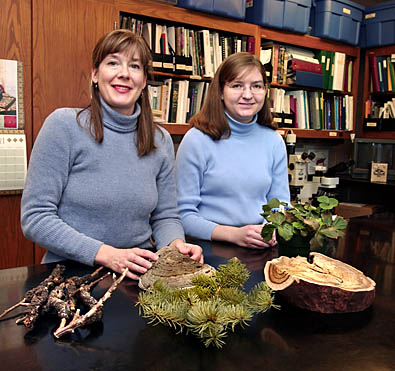Inside Iowa State | ||
Inside ArchivesSubmit newsSend news for Inside to inside@iastate.edu, or call (515) 294-7065. See publication dates, deadlines. About InsideInside Iowa State, a newspaper for faculty and staff, is published by the Office of University Relations. |
January 28, 2005 Team investigates plant problemsby Barbara McBreen, Agriculture Communications Know the difference between black knot and black spot? If not, you may want to contact the Plant Disease Clinic. Last year, almost 5,000 Iowans did just that. The clinic received 1,719 samples -- including whole plants, dry leaves, green leaves, stems, roots, branches and twigs. The staff also answered 3,267 calls, e-mails, faxes and letters about plant problems. Paula Flynn and Christine Engelbrecht, the clinic diagnosticians, investigate and respond to each inquiry with possible solutions or requests for more information. 
(From left) Paula Flynn and Christine Engelbrecht help Iowans discover what's wrong with their plants. The two clinic diagnosticians work for the university's Plant Disease Clinic in Bessey Hall. Photo by Bob Elbert. "We're the Crime Scene Investigators, or CSI, when it comes to plants," said Flynn, extension program specialist in plant pathology. "We put all the clues together to come up with the best answer." Diagnosing a problem can take 30 seconds or several weeks. Flynn said it's important to offer answers as quickly as possible so gardeners, farmers and landscapers can tackle potential problems. "We get a lot of garden and ornamental plant samples. We also get many samples from extension offices," Flynn said. "Gardeners often go to the county office and if those offices need more assistance or laboratory tests, they send samples to our clinic." During the growing season, the daily mail brings boxes filled with mysteries. Some include photographs of plants and their surroundings, which provide additional diagnostic clues. "The more we have in terms of samples and pictures, the more we can do," Flynn said. "We also need detailed descriptive background information. Was there construction in the area? How much do you water? Or, is there a downspout near a stressed tree?" Flynn showed one photo that accompanied a sample of brown leaves. It showed a parking lot, sidewalk and cemetery surrounding a tree. Flynn said her first diagnosis would include a combination of compaction problems and drought stress. "We were thankful for the picture because it pointed to site-related problems," she said. Plant problems can be caused by an endless number of factors that include insects, diseases, soil conditions and weather. "You would think we would have the same diseases show up over and over. But there are so many combinations of contributing factors, and some problems have four or five. Those are the hard ones," Flynn said. The clinic is located on the second floor of Bessey Hall. In a medium-sized room lined with cupboards, microscopes stand at attention on polished, black counters, waiting for spring. "It's quiet now but it gets crazy in here between May and August. It's a juggling act," Flynn said. She and her staff are preparing for a busy growing season. Asian soybean rust was discovered in North America for the first time in November. The disease was found first in Louisiana and since has been carried into eight southern states by hurricanes. Flynn and Engelbrecht are members of the Iowa Soybean Rust Team, which was formed two years ago to collect and disseminate information on how to manage the disease. The clinic staff, along with the rust team, began training crop specialists last summer on how to diagnose the disease. Iowa leads the nation in soybean production, and if soybean rust moves into Iowa, it could lead to increased production costs and decreased yields. "It's an uncertainty, but we're prepared to answer questions," Flynn said. The clinic's turn-around time was less than five days for 73 percent of the inquiries it received last year. Tree samples made up half the inquiries and field crop questions totaled 13 percent, followed by questions about perennials, annuals, woody ornamentals, fruit trees, turfgrass and vegetables. The clinic opened in 1956 in response to another major problem -- Dutch elm disease. For 32 years, faculty and graduate students handled client questions. In 1989, Flynn was hired as the first full-time diagnostician. Widespread diseases such as Dutch elm, which are imported into North America, prove to be the most harmful, Engelbrecht said. "Native plants don't have resistance to new diseases and that's why they are so devastating," she said. The newest disease threat to trees in Iowa is sudden oak death. Last spring, an alert went to several states after seedlings carrying sudden oak death were shipped from California. Engelbrecht helped inspectors analyze woody plant samples from area landscape and garden stores, which helped prevent the disease from entering Iowa. So what's the difference between black knot and black spot? Engelbrecht's answer: Black knot is a fungal disease that affects cherry trees and causes large black galls to form on the branches. Black spot is a fungal disease that affects roses and causes black spots to appear on the leaves. |
Quote"We're the Crime Scene Investigators, or CSI, when it comes to plants." Paula Flynn, |
|
Ames, Iowa 50011, (515) 294-4111. Published by: University Relations, online@iastate.edu. Copyright © 1995-2005, Iowa State University of Science and Technology. All rights reserved. |
||